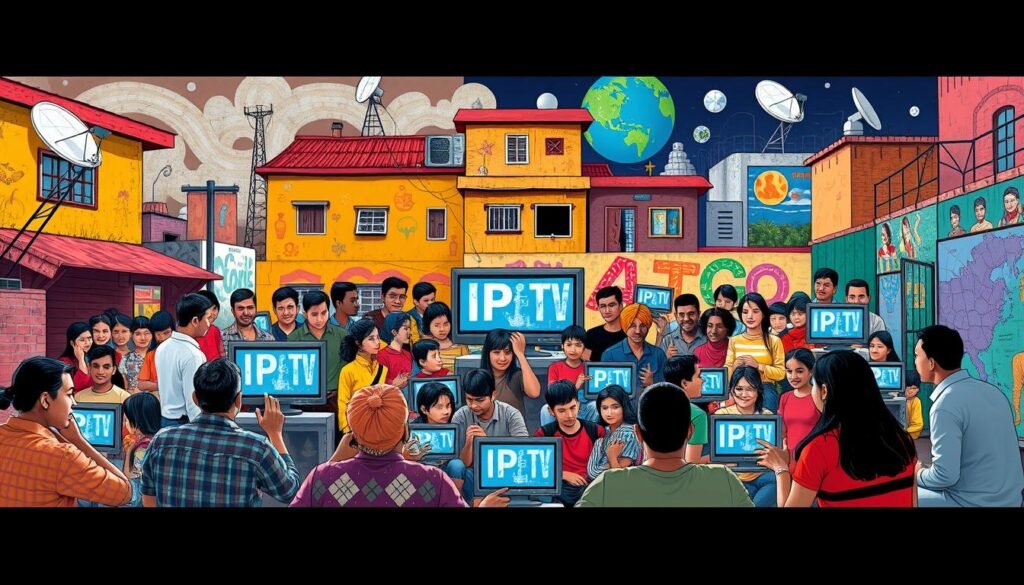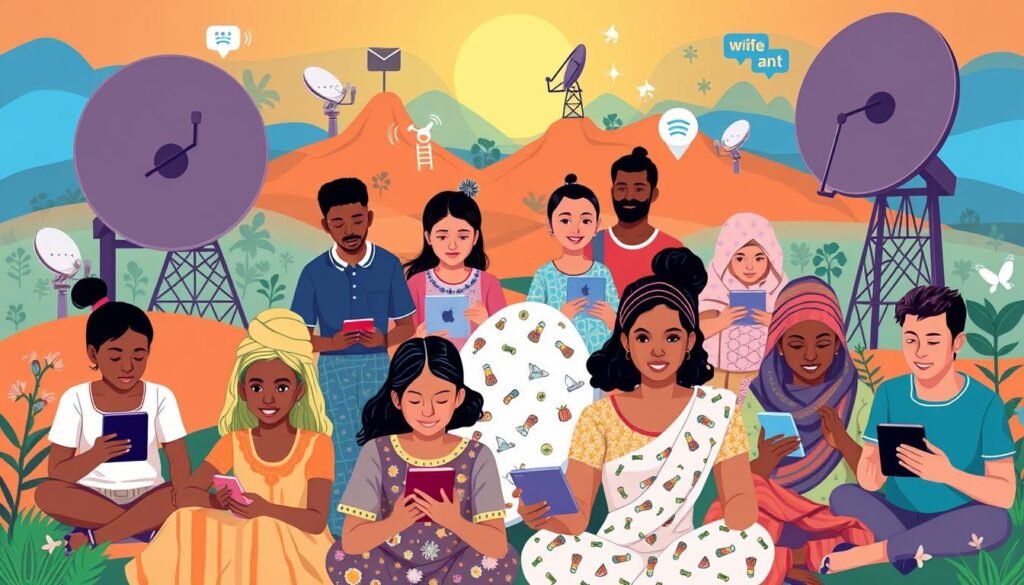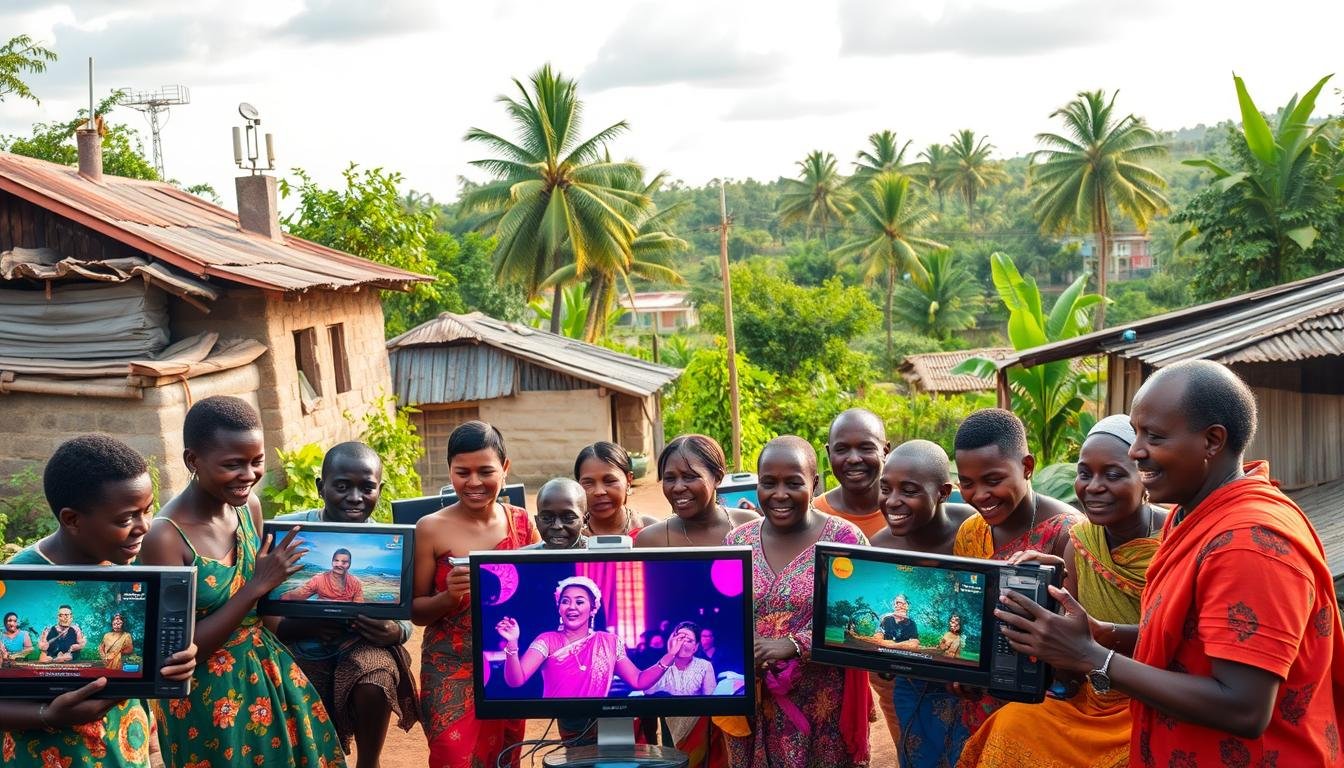In today’s world, getting to information, fun, and learning is a basic right. But, millions in developing countries still can’t access these things because of the digital divide. This divide stops people from getting better jobs and living better lives. But, a new technology called Internet Protocol Television (IPTV) is changing this.
IPTV sends TV shows over the internet. It’s a new way for people in poor areas to watch TV and learn new things. It uses the internet, which is already there in many places, making it cheaper and easier to use.
IPTV is making a big difference. It’s helping people who have been left out for too long. It gives them access to lots of educational and fun content. This opens up new chances for them.
Key Takeaways
- IPTV technology offers a cost-effective and accessible solution to bridge the digital divide in developing countries.
- IPTV can overcome the geographical and infrastructural challenges that have hindered the expansion of traditional television services.
- IPTV has the potential to drive digital inclusion and empower underserved communities by providing affordable access to a wealth of content.
- IPTV can unlock educational, informative, and entertainment opportunities for those who have historically been denied digital access.
- The implementation of IPTV in developing countries can catalyse social and economic progress by bridging the digital divide.
Understanding IPTV and Its Role in Digital Connectivity
The digital world is always changing, and IPTV (Internet Protocol Television) is leading the way. It’s changing how we watch TV, making it more like the internet. This new tech is bringing old TV and new digital ways together.
Basic Components of IPTV Systems
IPTV systems have a few main parts. These are the content source, IPTV server, network, and devices for watching. Thanks to new tech, IPTV can send top-quality video and sound over the internet. This gives viewers a fun and interactive watching experience.
Differences Between Traditional TV and IPTV
Traditional TV uses broadcast or satellite signals. But IPTV uses the internet. This change brings many benefits, like watching shows when you want and getting recommendations just for you. IPTV also lets you interact with shows in new ways, making watching TV more exciting.
Infrastructure Requirements
To use IPTV, you need a strong internet connection, IPTV servers, and devices that support IPTV. Building this infrastructure can be hard, especially in developing countries. But, IPTV is key to closing the digital gap and is worth the investment for the future.
“IPTV is not just a technological advancement; it’s a game-changer in the world of digital connectivity, empowering communities and transforming the way we consume content.”
The Current State of Digital Divide in Developing Nations
The digital divide is a big problem in developing countries. It’s the gap between those with and without access to digital technologies. The International Telecommunication Union says underserved communities in these countries often can’t get online. This makes it hard for them to use digital services and find new opportunities.
In many places, not enough people have broadband Internet. There’s a big difference between city and country areas. Without internet, people can’t get to important things like education, healthcare, and jobs. This makes poverty and inequality worse.
- Only 19% of people in the least developed countries have internet, compared to 86% in developed ones.
- Rural areas have it even tougher. They have limited infrastructure and high costs for broadband, making it hard to get online.
The digital divide stops people from getting information and using digital tools. It also holds back social and economic growth in these countries. We need to fix this to make sure everyone has a chance to succeed and to close the gap between those who are connected and those who are not.
“The digital divide is not just about access to technology, but about access to opportunity. It’s a barrier to economic and social progress that we must overcome.”
How IPTV is Bridging the Digital Divide
In developing countries, many communities face a big challenge: accessing modern media. Internet Protocol Television (IPTV) is a new hope. It brings Affordable Entertainment and Media Democratisation to more people.
Accessibility Features
IPTV makes digital content more accessible. It can be used on many devices, like smartphones and tablets. This lets even the most remote areas enjoy digital media.
Cost-Effective Solutions
IPTV is cheaper than traditional TV. It uses the internet, which is cheaper. This makes it easier for people with less money to enjoy TV.
Content Democratisation
IPTV has changed the media world. It lets small creators and businesses reach more people. It offers a wide range of content, from local shows to global hits.

“IPTV has the potential to transform the media landscape in developing countries, providing access to a wealth of information and entertainment that was once out of reach for many.”
IPTV is growing and reaching more people. It promises to bring the digital age to communities that were left behind.
Impact of IPTV on Rural Communities
IPTV technology has changed rural communities in developing countries. It has closed the digital gap, giving access to lots of information, fun, and learning. With remote access, IPTV helps bring digital inclusion to isolated areas.
IPTV brings a wide range of content to homes in rural areas. People can watch local and international shows, news, and educational stuff. This has made rural communities more aware of the world, helping them connect better with it.
| Remote Access Features | Digital Inclusion Benefits |
|---|---|
| Live TV Channels | Improved Literacy Rates |
| On-Demand Video Streaming | Enhanced Educational Opportunities |
| Interactive Learning Modules | Increased Civic Participation |
| Real-Time Communication Tools | Reduced Socio-Economic Disparities |
IPTV is also a cheap way to bring important services to rural areas. It uses broadband networks to offer healthcare, e-government, and more. This helps rural communities grow and become more inclusive.
The effect of IPTV on rural communities is huge. It has bridged the digital gap, bringing remote access and digital inclusion. This technology has opened doors to education, jobs, and social progress in the poorest parts of the world.
Economic Benefits of IPTV Implementation
IPTV (Internet Protocol Television) brings big economic gains to developing countries. It changes the digital world and helps growth last. This tech closes the digital gap and opens doors for jobs, local content, and bigger markets.
Job Creation Opportunities
IPTV has led to more jobs in many areas. This includes making content, setting up networks, and tech support. It helps local areas grow and creates jobs for many people. As IPTV grows, so does the need for skilled workers.
Local Content Development
IPTV changes how we watch and make media. It makes it easier for local creators to share their stories. This lets local content thrive, showing off the culture and languages of these countries. It also helps local industries grow and keeps stories alive.
Market Growth Potential
IPTV opens up big opportunities for market growth. More people can access digital content, helping businesses grow. IPTV is also cost-effective and scalable, attracting investors from home and abroad.
IPTV brings many economic benefits to developing countries. It creates jobs, boosts local content, and grows markets. By using IPTV, countries can find new ways to prosper and empower their people.
Technological Infrastructure Development
The use of IPTV in developing countries is boosting their tech infrastructure. Broadband Penetration and Technological Advancement are key for IPTV. This is changing the infrastructure a lot.
Improving broadband networks is a big focus. IPTV needs fast and reliable internet for smooth streaming. Countries are spending a lot on better broadband, making it faster and more widespread.
Building strong data centres and cloud computing facilities is also happening fast. These places are vital for hosting IPTV, storing lots of video, and sending it quickly to users.
Also, the growth of IPTV is pushing for new tech like 5G networks, edge computing, and advanced CDNs. These help make IPTV better, reaching more people and improving quality.
IPTV is not just about tech. It’s also about training people and growing a digital community. This whole approach makes sure IPTV brings lasting benefits.
“IPTV is not just a technology; it’s a catalyst for transforming the digital landscape in developing nations, paving the way for inclusive and equitable access to information and entertainment.”
As developing countries get into IPTV, they’ll see big changes. This will help them grow socially and economically.
Educational Opportunities Through IPTV
In developing nations, IPTV is a key tool to bridge the digital divide. It gives access to educational resources. Educators use it to bring Remote Access and Digital Inclusion to underserved communities.
Distance Learning Programmes
IPTV makes distance learning possible. Students in remote or underprivileged areas can now attend classes. They can also join in interactive lessons.
This approach removes barriers based on where you live. It makes sure quality education is available to everyone, no matter their location.
Educational Content Distribution
IPTV makes it easy to share educational content. This includes interactive multimedia lessons, virtual field trips, and documentaries. It helps students learn about many subjects.
This leads to a culture of lifelong learning. It encourages students to keep exploring and learning new things.
Skill Development Initiatives
- IPTV helps deliver vocational training and skill development programmes. It prepares people for the digital economy.
- Through interactive tutorials and virtual experiences, IPTV teaches technical, entrepreneurial, and soft skills. These skills are key for community empowerment and sustainable development.
By using IPTV, developing countries open up new educational paths. They are changing the educational scene. This unlocks the potential of their people.
Challenges in IPTV Implementation
IPTV has huge potential to help developing nations. But, it faces big challenges. One major issue is the lack of broadband penetration in many areas. Without reliable, fast internet, IPTV adoption is hard.
Another big challenge is the need for technological advancement. Many countries lack the skills and resources for IPTV systems. They need training and help to build these complex systems.
- Inadequate broadband infrastructure
- Lack of technological expertise
- Regulatory and policy challenges
- High implementation costs
- Content licensing and distribution issues
There are also regulatory hurdles and missing policies. Governments need to create clear rules for IPTV. This will help make it easier to use and grow.
| Challenge | Description |
|---|---|
| Limited Broadband Penetration | Many remote and rural areas lack reliable, high-speed internet connectivity, hindering the widespread adoption of IPTV services. |
| Technological Expertise Gap | Developing countries often lack the technical knowledge and resources required to deploy and maintain IPTV infrastructure. |
| Regulatory and Policy Challenges | Absence of clear regulatory frameworks and supportive policies can create barriers to IPTV implementation. |
| High Implementation Costs | The financial investment needed to establish IPTV systems can be prohibitive for many developing nations. |
| Content Licensing and Distribution | Navigating the complexities of content licensing and distribution can pose additional challenges for IPTV providers. |
Beating these challenges is key to making IPTV a game-changer for developing countries. It can help bridge the digital gap and bring new opportunities.
Government Initiatives and Policy Support
In developing nations, governments are working hard to use IPTV to close the digital inclusion gap. They aim to push technological advancement forward. By creating good rules and teaming up with the private sector, they’re making a brighter future for all.
Regulatory Frameworks
Many countries see IPTV as a game-changer. So, they’ve made special rules to help it grow. These rules help build better networks, offer more content, and make sure everyone can access it.
By setting out clear rules and offering help, governments are making it easier for IPTV services to reach everyone. This includes even the most far-off places.
Public-Private Partnerships
Also, governments are teaming up with private companies to get IPTV out faster. They use the private sector’s know-how and money to help everyone get online. This teamwork is not just about getting more people connected. It also creates jobs and boosts local content.
By working together and making rules, developing countries are setting the stage for IPTV to be a big help. It will bring digital inclusion and technological advancement to millions of lives.

Future Prospects of IPTV in Developing Countries
The world is seeing fast Technological Advancement. IPTV (Internet Protocol Television) looks set to grow in developing countries. It has already helped close the digital gap, and its influence is set to increase.
The demand for top-notch Streaming Services is rising in these areas. More people are getting online, wanting more digital content. IPTV can offer a smooth viewing experience and lots of shows, meeting this need.
Mobile tech is getting better, and smart devices are becoming cheaper. This means more people can enjoy educational and fun content. It helps them join the digital world.
Leaders in developing countries see IPTV’s big potential. They’re working on rules, investing in tech, and teaming up with private companies. This will help IPTV reach more people.
IPTV is changing lives in developing nations. It’s improving digital access, helping the economy, and enhancing life quality. The future of IPTV here is very promising, offering new chances to those who need them most.
“IPTV is not just a technological advancement, but a transformative tool that has the power to elevate communities and empower individuals in developing countries.”
Success Stories and Case Studies
IPTV has changed the game in digital inclusion and affordable entertainment, especially in developing nations. Two standout examples show its huge impact.
In rural India, IPTV has changed how people access digital content. The Digital India project, backed by the government, has made broadband and lots of educational and fun shows available. Now, villagers can watch a variety of local and international shows, promoting cultural exchange and access to information.
In Kenya, too, IPTV has made a big difference. A Nairobi start-up, Zuku, offers a cheap IPTV service. It gives Kenyan homes lots of TV channels, on-demand shows, and interactive features. This has helped communities get entertainment and learning resources they couldn’t afford before.

